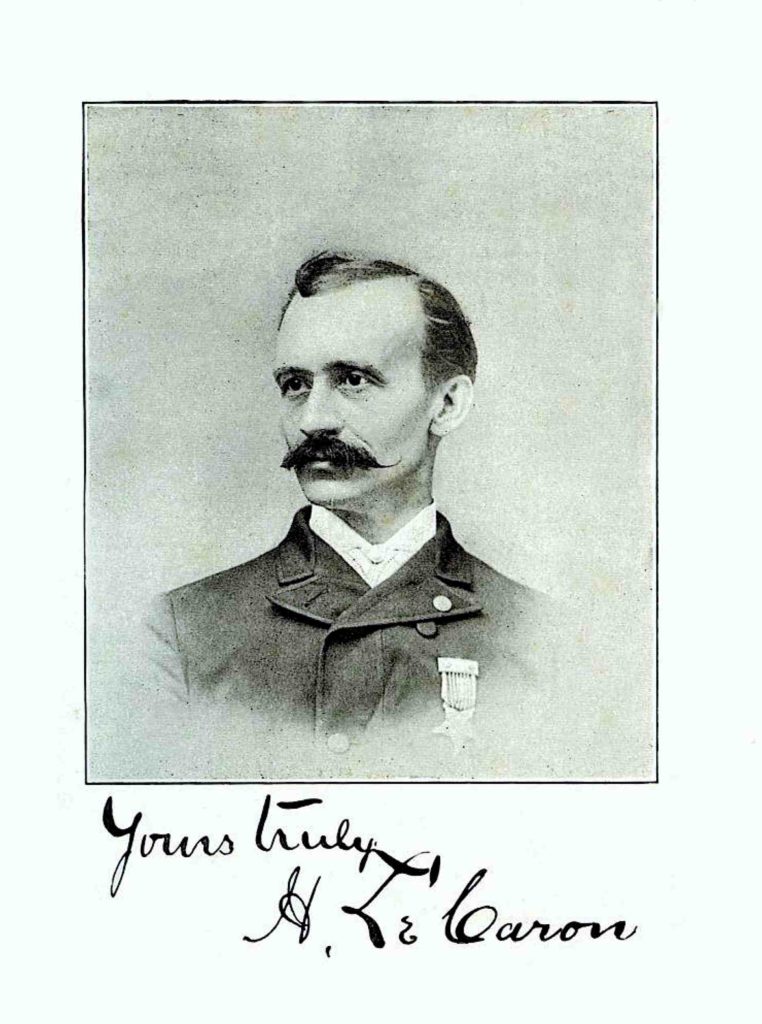The (in)famous Dr. Henri Le Caron, pride of Braidwood

By Sandy Vasko
Several former Braidwoodites have achieved national and even international recognition. We think of Anton Cermak for instance. But few think of the 19th century man who brought international attention to Braidwood, Henri Le Caron. Let us look at the remarkable man who lived three lives, one as a French doctor and pharmacist, one as a man loyal to the Irish Rebellion, and lastly his real self, a loyal British spy.
We will start with the first persona, that of a French doctor. It was this person that Braidwood knew and loved.
In 1878, George Woodruff published a history of Will County, including biographies of all the important persons in it. For Henri Le Caron he wrote: “The subject of this sketch is one of the most prominent men of Reed Township; was born in France Sept. 26, 1839, and is the son of Francis V. LeCaron, who was a speculator and money broker.
“Dr. LeCaron remained in France until the breaking-out of the late war; he then, with the intention of enlisting in the Union army, emigrated to America Aug. 20, 1861. He first enlisted in the body guard of Maj. Anderson; was also body guard of Gen. Buel; in 1862, he enlisted as Sergeant in the 15th Penn. Calvary, and participated in some of the most prominent battles – Antietam, Stone
River, Chickamauga; in July, 1864, was commissioned as 2d Lieutenant in the Regular U.S. A., 13th Regiment; was wounded in the side in a skirmish in Tennessee; was mustered out as 1st Lieutenant in
March, 1866; was with Gen. O’Neal’s Canada movement in 1866.
“He then came to Illinois, and settled in Lockport, Will County; there he was engaged in the flour-mills of Norton & Co. In 1870, was a participant in the great Fenian (Irish independence) movement. In 1868-69 he attended the Rush Medical College, of Chicago; in 1872, graduated in the Detroit Medical College, of Detroit, Mich.
“He then came to Will County, and has engaged in the practice of medicine ever since; in 1873, came to Braidwood. Was Supervisor of Reed Township in 1875. Democrat in politics; was in August, 1878, nominated by the Democratic Party for Representative.”
Wow! What a guy! And he was the sort of guy who participated in his community. He was involved in St. Rose of Lima in Wilmington, Immaculate Conception in Braidwood, the Grand Army of the Republic, and defeated Braidwood himself for supervisor of Reed Township.
He was often in the local papers for his excellent treatment of cancer victims, mining injuries, and became a specialist in treating the wounds of shooting victims.
We read in October 1875: “About midnight Tuesday last, a wedding ball at Jas. Kane’s saloon ended in a shooting affray – Hugh Carney being shot by a stranger from Maryland named Maloy, for some fancied or real insult. The bullet went in at the nose passing through the cheek behind the eye from which delicate place Dr. Le Caron extracted it; it is a pretty close call.”
He was generous to a fault. We read in April of 1879: “Dr. Le Caron’s salary, as a member of the Board of Health, which amounted to $25, and was allowed at the last meeting of the council, has been donated by the Dr. to the public library.”
In that same year, Henri opened a drug store on Main Street, with a great view of everything that was happening downtown. In 1883, he became the fourth president of the Illinois State Pharmaceutical Association after being vice-president the preceding year. His actions in the aftermath of the Diamond mine disaster, one of Illinois’ worst coal mine disasters with 68 deaths, were recorded as exemplary as were his efforts to promote relief for the families of the victims of the disaster.
This Henri LeCaron was indeed the pride of Braidwood. If only that person were real, but he wasn’t.
The man Braidwood came to know as Henri LeCaron was born Thomas Miller Beach on September 26th, 1841, in Colchester, England. After a number of failed attempts, he managed to run away from home, to Paris where he became a drapers’ (cloth merchant) assistant.
He became acquainted with members of the American expatriate community there, and when shots were fired at Ft. Sumter, he embarked on the liner Great Eastern on her first voyage to New York. He signed up as a private in company with several of his American associates from Paris, for a three-month enlistment. It was at this point he assumed the name Henri LeCaron, a name he took from a family he had met while in Paris.
His career in the Union Army is foggy, and it is clear that he did not participate in all those glorious battles that he claimed, but his name is listed as one of those who mutinied at the battle of Nashville.
LeCaron became aware of Fenian (Irish rebel) activities among Irish Union army veterans following the war, and being situated in Nashville when his regiment mustered out, he fell in with a band of Union veterans led by General O’Neill who were planning an invasion of Canada as part of a bid to gain independence for Ireland.
He later wrote home to his father of this fanciful plan, and the letter was passed on to John Rebow, Member of Parliament for Colchester. This same letter ended up in the hands of Scotland Yard, and thus began his 25 years of reporting on Fenian activities to Sir Robert Anderson, his liaison with Scotland Yard.
O’Neill’s command crossed the Niagara and engaged the alerted Canadian provincials at Ridgeway. LeCaron as Adjutant-General managed to misdirect ordinance and supplies in such a way as to cause a Fenian retreat, and all action was ended when President Johnson enforced the Neutrality Laws.
We will leave Le Caron there until next time, when he discovers the greener pastures of Will County.
